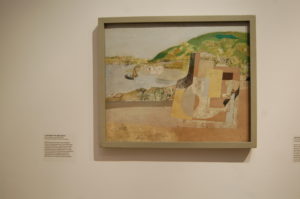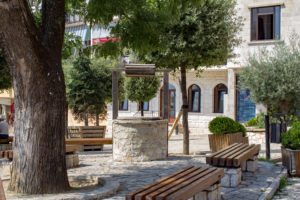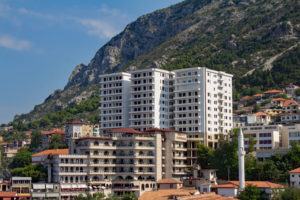The town of Kruja is built on a mountain side, at around 500m above sea level, with the Adriatic on the other. The name comes from the Albanian word for a spring, krua, within the castle which provided it with water.
From our balcony at the “Hotel Panorama”:https://www.silvertraveladvisor.com/review/accommodation/200192-review-hotel-panorama-kruja, we could see the roof tops of the single street pedestrianised bazaar as it meandered up towards the castle. The original bazaar had been bombed during World War 2 and this small section was restored in the mid-1960s with an authentic Ottoman feel. The eaves were extra-long, and the gutter built into the middle of the path to allow water to drain off and run straight down. Outside many shops were piles of wooden planks which were inserted individually each night as shutters.
The small shops sold souvenirs: some imported with others being handmade using the old traditional crafts, now in danger of dying out. We saw felt makers (for hats and slippers), carpet shops (with women weaving on looms in their shops) and ‘antiques’ which had been collected over the years (babies cradles, butter churns and pats, German war helmets, coffee grinders, one and two stringed musical instruments). There were also linens and lace tablecloths, national costumes, cushions, thick hand knitted woollen socks, and many goods with the black double headed falcon on red reflecting the national flag etc. This area was totally cobbled, and flat shoes are a must if you want to avoid a twisted ankle.
The “Castle”:https://www.silvertraveladvisor.com/review/attraction/200217-review-kruja-castle, with its “Historical Museum”:https://www.silvertraveladvisor.com/review/200362 and “Ethnographic Museum”:https://www.silvertraveladvisor.com/review/200377 Ethnographic Museums are the main sights in Kruja. From our balcony we noticed a now defunct well that was often surrounded by locals chatting under olive trees on seats nearby, just as they would years ago when people would fetch water. A walk out to the entrance of the town took us to a statue of the Albanian hero, Skanderbeg, in his trademark goat head helmet, on horseback.
Our hotel and many low-rise buildings would have had wonderful views of the surrounding mountains if it had not been for a huge relatively new apartment block. This blocked the views of buildings above them and the view of the mountain from the town. Mary, our guide, told us she was so incensed by the construction that she wrote to the Prime Minister who failed to reply.
After our afternoon of sight-seeing we sat on a raised terrace at the Taverna e Vjeter overlooking the bazaar with a glass of wine, people watching and waiting for the sun to set. As it was later than anticipated, we decided on a second glass of what was a passable dry white. The bill came to 800 Lek and we proffered a 1,000 note. When change failed to return, we asked the young waiter, who had been very friendly and helpful for the change, and he said he thought we’d left it for him. A 25% tip for serving four glasses of wine seemed a little excessive and so we told him that not only did we want the 200, we would now not be leaving the 10% which we’d earmarked. As Kruja is often the first destination of tourists, we felt they were assuming people will not have got their head round the currency exchange or are two polite to ask – we were neither.










